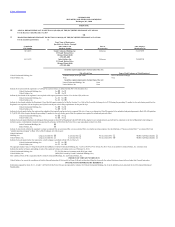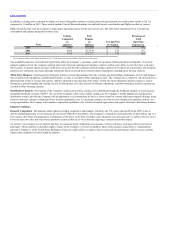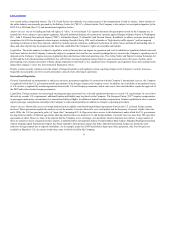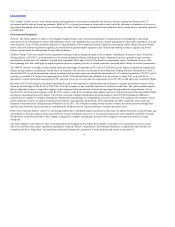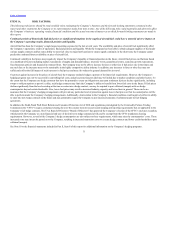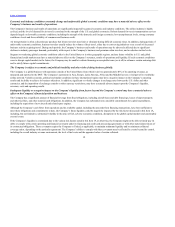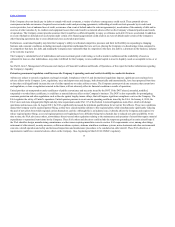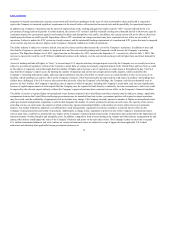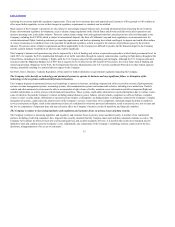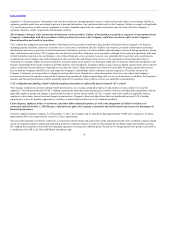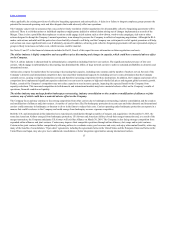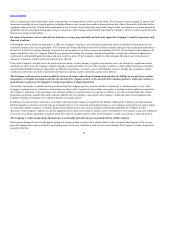United Airlines 2013 Annual Report Download - page 8
Download and view the complete annual report
Please find page 8 of the 2013 United Airlines annual report below. You can navigate through the pages in the report by either clicking on the pages listed below, or by using the keyword search tool below to find specific information within the annual report.
Table of Contents
over certain airline competition matters. The U.S. Postal Service has authority over certain aspects of the transportation of mail by airlines. Labor relations in
the airline industry are generally governed by the Railway Labor Act (“RLA”), a federal statute. The Company is also subject to investigation inquiries by the
DOT, FAA, DOJ and other U.S. and international regulatory bodies.
Access to landing and take-off rights, or “slots,” at several major U.S. airports and many foreign airports served by the Company are, or
recently have been, subject to government regulation. Federally mandated domestic slot restrictions currently apply at Reagan National Airport in Washington
D.C., John F. Kennedy International Airport (“JFK”), LaGuardia Airport (“LaGuardia”) and Newark Liberty. In addition, to address concerns about airport
congestion, the FAA has designated certain airports, including Newark Liberty, JFK, and LaGuardia as “high density traffic airports” and has imposed
operating restrictions at these three airports, which may include capacity reductions. Additional restrictions on airline routes and takeoff and landing slots at
these and other airports may be proposed in the future that could affect the Company’s rights of ownership and transfer.
The airline industry is subject to legislative activity that may have an impact on operations and costs. In addition to significant federal, state and
local taxes and fees that the Company is currently subject to, proposed taxes and fees are currently pending that may increase the Company’s operating costs if
imposed on the Company. Congress may pass legislation that could increase labor and operating costs. The Airline Safety and Federal Aviation Extension Act
of 2010 and the FAA Modernization and Reform Act of 2012 have increased regulation and are likely to cause increased costs in the areas of airline safety,
pilot training, and consumer protection. Climate change legislation is also likely to be a significant area of legislative and regulatory focus and could adversely
impact the Company’s costs. See , below.
Finally, aviation security continues to be the subject of frequent legislative and regulatory action, requiring changes to the Company’s security processes,
frequently increasing the cost of its security procedures, and adversely affecting its operations.
International Regulation
International air transportation is subject to extensive government regulation. In connection with the Company’s international services, the Company
is regulated by both the U.S. government and the governments of the foreign countries the Company serves. In addition, the availability of international routes
to U.S. carriers is regulated by aviation agreements between the U.S. and foreign governments, and in some cases, fares and schedules require the approval of
the DOT and/or the relevant foreign governments.
Foreign countries are increasingly enacting passenger protection laws, rules and regulations that meet or exceed U.S. requirements. In cases where
this activity exceeds U.S. requirements, additional burden and liability may be placed on the Company. The European Union (“EU”) requires compensation
to passengers under many circumstances for canceled and delayed flights, in addition to denied boarding compensation. Similar regulations in other countries
require passenger compensation and subject the Company to enforcement penalties in addition to changes in operating procedures.
Historically, access to foreign markets has been tightly controlled through bilateral agreements between the U.S. and each foreign country
involved. These agreements regulate the markets served, the number of carriers allowed to serve each market and the frequency of carriers’ flights. Since the
early 1990s, the U.S. has pursued a policy of “open skies” (meaning all U.S.-flag carriers have access to the destination), under which the U.S. government
has negotiated a number of bilateral agreements allowing unrestricted access between U.S. and foreign markets. Currently, there are more than 100 open skies
agreements in effect. However, many of the airports that the Company serves in Europe, Asia and Latin America maintain slot controls. A large number of
these are restrictive due to congestion at these airports. London Heathrow International Airport, Frankfurt Rhein-Main Airport, Shanghai Pudong International
Airport, Beijing Capital International Airport, Sao Paulo Guarulhos International Airport and Tokyo Haneda International Airport are among the most
restrictive foreign airports due to capacity limitations. As an example, under the 2010 United States-Japan open skies agreement, only four slot pairs are
available in Haneda to U.S. air carriers at this time, none of which is held by the Company.
8

